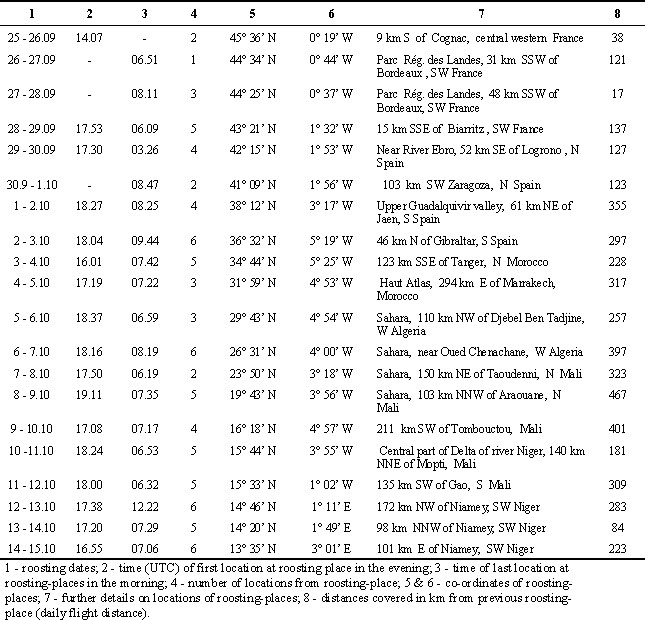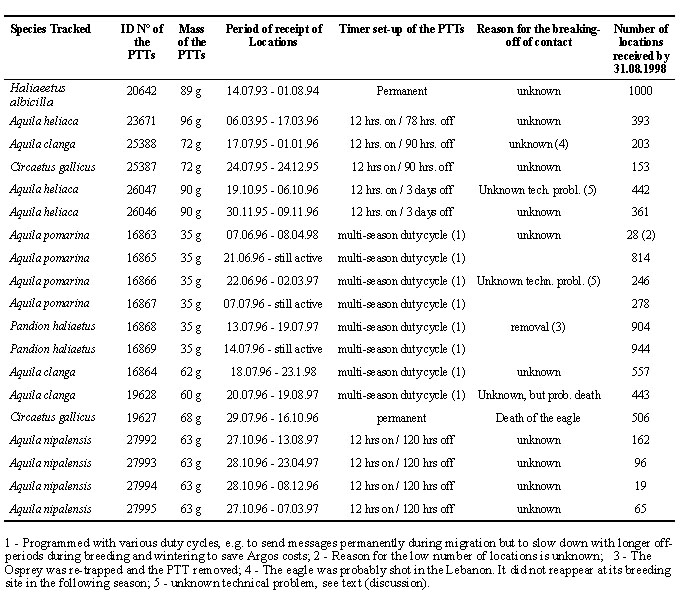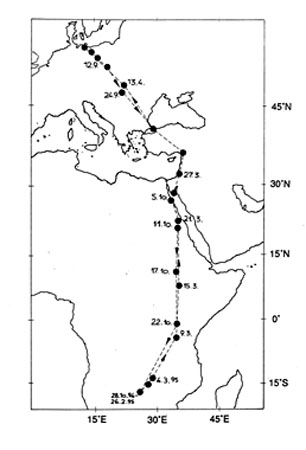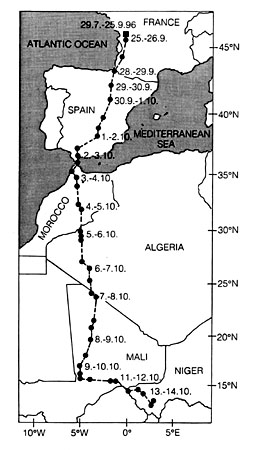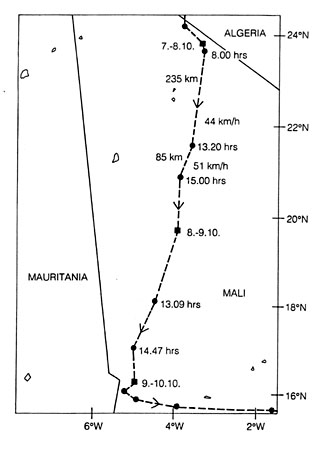We reproduce here an article which has been published in the Proceedings of the 22nd International Ornithological Congress, Durban, August 1998
S49.2: The study of raptor migration in the Old World using satellite telemetry
Bernd-Ulrich Meyburg & Christiane Meyburg
World Working Group on Birds of Prey, Wangenheimstr. 32, 14193 Berlin, Germany, fax 49 30 892 80 67, e-mail WWGBP@aol.com
Meyburg, B.-U. & Meyburg, C. 1999. The study of raptor migration in the Old World using satellite telemetry. In: Adams, N.J. & Slotow, R.H. (eds) Proc. 22 Int. Ornithol. Congr., Durban: 2992-3006. Johannesburg: BirdLife South Africa.
Many raptor species in the Old World spend over half the year on migration and on their wintering grounds. To study these still only very slightly known phases of the annual cycle we equipped with satellite transmitters (PTTs) between July 1992 and July 1998 75 raptors in Europe, Asia and Africa belonging to eleven different species. For the first time ever in ornithology it has been possible to record in detail the complete yearly movements of adult birds of several species, their outward and return migrations between their breeding territories and their wintering grounds. This has revealed several unexpected and unknown routes taken, such as, for example, that of an adult Greater Spotted Eagle which spent from December to March in Zambia, far south of the species’ hitherto known winter range, or that of an Imperial Eagle which shuttled along an almost east-west route between northern China and western Arabia. The latest solar-powered transmitters permit for the first time a detailed tracking of, for instance, Ospreys, as they surmount major ecological barriers such as the Sahara, the Mediterranean and the Alps. Precise locations of overnight roosting-places enable one to reckon the daily distances covered, which have shown considerable variation with all the species investigated. Thus, for example, an adult Short-toed Eagle
Circaetus gallicus
on its autumn migration from France to Niger veered each day between 17 and 467 km (average 234 km). In individual cases it could be shown that birds flew well over 500 km in one day. A clear dependence on weather conditions was frequently apparent.
INTRODUCTION
Many species of birds spend over half the year away from their breeding areas on migration and on their wintering grounds. Breeding and wintering areas often lie many thousands of kilometres apart. Thus their annual migratory journeys form one of the most impressive phenomena in animal biology.
For around one hundred years the migratory behaviour of birds has been studied mainly with the help of ringing. Ringing or banding, however, provides virtually no information as to the course of migration since generally it pinpoints only two locations, the place of ringing and the place of recovery. The actual route followed during migration remains unknown. Furthermore, practically nothing is known about the speed at which the birds migrate, the daily distances covered, the various stages en route, whether the birds migrate directly to their winter quarters or whether they break the journey at certain fixed points, whether they stray nomadically over their wintering grounds or occupy a well-defined territory there, etc. The recovery rate amounts to a fractional percentage, so that with rare species often no satisfactory results can be obtained due to the small number of recoveries.
Other, modern methods, such as conventional telemetry, radar tracking, observation from gliders and at migration bottlenecks are powerless to shed any light on many questions regarding the course of migration.
Although first used in ornithological research only a few years ago (Srickwerda et al. 1986, Howey 1992, Seegar et al. 1996, Meyburg & Meyburg 1996, Berthold et al.
1997,) satellite telemetry has already provided surprising new information regarding raptor migration (Meyburg et al. 1993, 1995 a, b, 1996 a, b, Meyburg & Meyburg 1997 a, b, Grubb et al. 1994, Brodeur et al.
1996, Kjellen et al.
1996). It has made it possible for the first time to keep constant track of individuals on their migrations throughout the world and thus obtain a concise picture of migration dynamics, which was never possible with the methods hitherto available.
METHODS AND AIMS
Since by the beginning of the 1990s PTTs had become smaller and more reliable, we embarked on a research programme using them to investigate raptor migration in the Old World. Between July 1992 and July 1998 we equipped 75 raptors in Europe, Asia and Africa belonging to 11 different species with PTTs ranging in weight from 30 to 95 grams. These were: 21 Lesser Spotted Eagles
Aquila pomarina; 16 Steppe Eagles Aquila nipalensis; 11 Ospreys Pandion haliaetus; 9 Greater Spotted Eagles Aquila clanga; 8 Imperial Eagles Aquila heliaca; 3 Short-toed
Eagles Circaetus gallicus; 2 Egyptian Vultures Neophron percnopterus; 1 White-tailed Sea Eagle Haliaeetus albicilla; 1 Steller’s Sea Eagle Haliaeetus pelagicus; 1 Peregrine Falcon Falco peregrinus
. These birds were equipped in Germany, Slovakia, Poland, Hungary, Latvia, Russia, France, Saudi Arabia, Namibia and South Africa. Our principal aims were : -
(1) To record as fully as possible the complete annual migratory cycles of adult birds, namely their journeys from breeding place to winter quarters and back to breeding place the following year; (2) to investigate the complete routes taken each year by immatures; (3) to investigate the behaviour of juvenile birds on migration; (4) to compare the annual routes of the same individuals over the course of two or more years, if possible; (5) to equip whole families, in order to discover the migratory behaviour and perhaps the degree to which members of a family stayed together; (6) to find out at what speed the birds travel, the daily distances covered by them and how this is influenced by weather conditions; (7) to establish whether and, if so, in what way ecological barriers such as mountains, seas and deserts are crossed and (8) to find out whether the birds are in any way handicapped by the transmitter and whether birds thus equipped can reproduce successfully.
Regarding the choice of species, we allowed ourselves to be guided in essentials by the following criteria: -
To begin with, while a reduction in size of the transmitters was only gradually being achieved, we had to confine ourselves to the larger species. Later on we could also investigate medium-sized species.
Preference would be given to those species which, according to present knowledge, undertook extensive or very extensive peregrinations.
Preference would equally be given to species about whose behaviour on migration and the route followed particularly little was known.
We began our satellite telemetry programme with the aim of investigating the behaviour on migration of the larger eagle species because of transmitter size, above all to record as fully as possible the complete annual cycle of adult birds. We concentrate less on tracking juvenile and immature birds, the migration strategy of which is different in many ways, on account of their substantially higher mortality rate and hence lower degree of success in relation to the costs involved.
To begin with, only battery-powered PTTs were available, and these had the disadvantage of a very limited lifespan. To prolong this, the transmitters were so programmed that they gave out signals for only 8 hours over the space of two or more days. In this way they could be made to last for between 6 and 12 months. The shortcoming of this was the obviously small amount of data received, so that the migration route could not be recorded in great detail (e.g. Meyburg
et al. 1995 c, 1996 b).
In 1993 the first solar-powered PTTs became available, while also being increasingly reduced in size. Particularly since 1995, solar-powered PTTs have now been put into service, thereby solving the problem of the batteries’ limited capacity (Meyburg & Meyburg 1998). Given a sufficient degree of light, these PTTs can provide signals permanently. The amount of data collected with these PTTs was incomparably greater, so that precise answers could be found for such questions as the distances covered daily. Whereas previously the capacity of the batteries was the limiting factor of the whole system, the shortcoming now lies primarily in the Argos System, whereby the quantity of data is governed by the number of times the satellite passes. It is hoped that this will improve following the projected doubling of the number of satellites and the increased sensitivity of the receiving sets.
To start with we equipped nestlings, since this was the simplest method. On account of the high mortality rate of young birds, however, we turned increasingly to trapping adults and immatures for equipping with PTTs.
For the tracing of the migration route and computer calculation of distances covered between Argos locations we used an integrated global mapping system displaying a true Mercator projection. The migration route was also traced by a variety of CD-ROM-Atlases, in order to ascertain dependence on altitude, habitat types, etc. During the migration the length of day and times of sunset and sunrise at each overnight roosting-place were calculated using a special computer programme (Fly-By-Day Consulting, Inc., CompuSolve, Inc., and Leslie O’Shaughnessy Studios) by means of the Internet. Various programmes on the Internet were consulted for weather data, particularly satellite photographs.
RESULTS Annual routes taken by adult birds
Our aim of recording complete annual migrations was achieved with several species (e.g. Lesser Spotted Eagle, Imperial Eagle, Osprey). For the first time with a European migrant the complete routes taken by an adult male Lesser Spotted Eagle from Germany to Zambia and back could be documented (Meyburg
et al
. 1995 a). Up to 5 September 1994 this bird remained in its breeding area. After a journey of almost 9,000 km over the Bosphorus and the Sinai peninsula it reached its wintering grounds in southern Zambia, west of Lusaka, on 28 October. On 26 February 1995 it set off again, arriving on 22 April at its old nest site in Germany (see
Fig. 1
). The transmitter thus functioned for close to 11 months. Throughout this time the eagle was tracked over a total distance of 19,400 km. During migration it flew a daily average of 166 km.
Several adult Lesser Spotted Eagles and others are at present being tracked by means of solar-powered transmitters, providing a mass of details regarding the routes taken on migration between their breeding and wintering areas in Europe, Asia and Africa.
Behaviour on migration of immature birds
The routes followed by immature birds were in general similar to those of adults. They differed, however, in their duration. They spent more time in their winter quarters and less in the breeding area than the adults. Thus one subadult female Lesser Spotted Eagle left its wintering grounds in Namibia only at the end of March; it did not cross the Bosphorus until 23 May, reaching its summer quarters in Ukraine only at the end of May. An immature Lesser Spotted Eagle, which had also wintered in Namibia, did not arrive at its summer quarters in Hungary until 26 June. Breeding adults leave their wintering grounds around the end of February, arriving in their breeding territories in mid-April. In the same way two immature Steppe Eagles first arrived in the breeding area in mid-May, 1 ½ months later than the adults.
Hitherto unknown migration routes and wintering grounds
The annual routes taken by an immature Imperial Eagle, trapped and fitted with a PTT in March 1995 near Taif in western Saudi Arabia, were surprising. It migrated to northern China in the Sinkiang Uighur Autonomous Region near the Mongolian border, where it spent the summer. For the winter it again returned to western Saudi Arabia, following which it could be tracked for a second time on its spring migration to China until contact was broken off. The surprise was the strong east-west orientation of the bird's route. One would have expected an Imperial Eagle from northern China to overwinter in southern Asia, e.g. India.
Even more surprising were the routes and wintering grounds of a pair of Greater Spotted Eagles from Poland. According to existing knowledge these eagles overwinter in north-east Africa, in Egypt, the Sudan and Eritrea. Only exceptionally were Greater Spotted Eagles observed in Kenya and Uganda. The female, fitted with a PTT in July 1996, overwintered in Chad. The male, on the other hand, came as a complete surprise: it flew as far as the 15th latitude south in Zambia where it spent the winter in the South Luangwa National Park, around 1,500 km further south than any previous record of a Greater Spotted Eagle.
Ecological barriers
As was expected, crossing of the sea was avoided by all species except for Osprey and Peregrine Falcon. The Steppe, Lesser Spotted and Short-toed Eagles which we tracked flew over typical concentration points like the Bosphorus, the Straits of Gibraltar and Bab-el-Mandeb. For the first time, however, it could be established how two Ospreys crossed the Mediterranean Sea at its widest point. An adult female on migration from Germany left the Italian coast near Genoa flew almost due south and spent the night in south Sardinia. The next morning it proceeded to Tunisia. Its male partner started across the Mediterranean from near the Rhone delta, spending the night on Majorca and flying on to Algeria the next day.
Daily flight distances
Few researchers have attempted to quantify the distance migrants fly in one day (Kerlinger 1989). The paucity of measurements was related to technical difficulties and the expense of following birds for long distances with an aircraft. Researchers have been thwarted by topography, geopolitical borders, weather, equipment failure, and expense. Peregrine Falcons (
Falco peregrinus) tracked from an aircraft flew up to 330 km per day during autumn migration in North America. The average daily distance of three birds was 185 km (Cochran 1975).
Following migrating flocks of Broad-winged Hawks Buteo platypterus by a motor glider flying 40 to 150 km during autumn migration revealed cross-country speeds of 37.5 to 44 kph (Hopkins 1975, Hopkins et al.
1979, Welch 1975). Steppe Eagles Aquila nipalensis
tracked by radar had an average cross-country speed of 44.6 (+/- 17.7) kph during migration in Israel (Spaar & Bruderer 1996). Lesser Spotted Eagles followed by a motorised glider in Israel migrated with an average velocity of 50.9 kph (+ / - 6.7) (Leshem & Yom-Tov 1996).
Cochran (1975) observed that there was a large variation in flight time with different weather conditions. A migrating Peregrine Falcon Falco peregrinus
ceased migration by 12.00 hrs on days when winds were opposed to the migratory direction. He followed this immature male fitted with a conventional radio transmitter by aircraft during its autumn migration from Wisconsin (USA) to Mexico, 2,620 km in 15 days. The average cross-country speed was 33 kph and the daily distance averaged 175 km.
An adult male Bald Eagle (Haliaeetus leucocephalus
) was tracked from an aircraft by Harmata (1984) during spring migration from Colorado to Saskatchewan in North America. During its 15 day migration the eagle spent 6 days 'sitting out bad weather' and averaged about 220 km on the days it migrated.
Speed of flight during migration of our birds tracked by satellite was very variable. The stages covered by an immat. Short-toed Eagle varied between around 100 and at least 234 kilometres per day. One Lesser Spotted Eagle tracked by satellite over its complete autumn and spring migrations flew an overall average of 166 km per day, whereas the immat. Short-toed Eagle flew an average of only 135 km per day over a much shorter distance. The average length of each daily stage was 150 km for a Greater Spotted Eagle (Meyburg
et al. 1995a). It has now been possible to pinpoint all the overnight stopping-places of a raptor on migration (see
From its departure up to the 14th day the daily flight distances increased steadily, culminating on the 14th day in the maximum stretch of 467 km. From then on the length of each daily stage decreased almost continuously. On three days in all less than 100 km were covered, and on five days 100-200, 200-300 and 300-400 km respectively. On two days the bird flew the greatest distances, of 467 and 401 km, as it crossed the Sahara in northern Mali. The shortest distance was on 27 September with a mere 17 km covered in France. This was plainly due to the bad weather, when it rained almost throughout the day.
During its journey the bird spent four nights in France, four in Spain, two in Morocco, two in Algeria, five in Mali and four in Niger. The relatively high number of night-time locations is remarkable.
With the other species the daily distances covered also varied considerably. The longest stretches recorded were for an Osprey, a Lesser Spotted Eagle and an Imperial Eagle. On 4 September 1996 the Osprey covered 550 km when crossing the Mediterranean from the Italian coast near Genoa to southern Sardinia. The Lesser Spotted Eagle, on the 28 October 1996, flew 537 km through northern Sudan. In both cases the respective roosting-places could be located so accurately that the actual distances covered between them could be calculated.
Cross-country speed
Unfortunately it is rare to obtain two exact locations within a relatively short space of time, whereby the average cross-country speed can be assessed. Examples of this are provided by the two Short-toed Eagles. The immature bird, on 3 September 1995, covered 157 km between 10.14 and 13.54 hrs, giving an average of 43 kph (Meyburg
et al. 1996 a). The most accurate estimate of mean cross-country migration speed of the adult Short-toed Eagle was made possible by two good locations in quick succession on 8 October (see
Daily rhythm
Data obtained e.g. from the adult Short-toed Eagle yielded information on its daily rhythm during autumn migration. Due to the time lapse of ca. 1.5 to 2 hours between passages of the satellites, the times of arrival at a roosting place and departure the next morning could be estimated only very approximately. As shown by
Table 1
, the bird had often already arrived at its roosting-place by 17.20 hrs. In two cases it was already located there at 14.07 and 16.01 hrs. Throughout the whole migration the sun set between 17.46 and 18.02 hrs, and rose between 05.53 and 06.18 hrs. In all likelihood the bird often broke off its journey long before the first locations from its roosting-place.
Thus, for example, on 5 October it was located on the move at 15.38 hrs. Thereafter it covered only 27 km to its roosting-place, so must have arrived there around 16.10 hrs. On 6 October it was located at 15.25 hrs still 106 km from its roosting-place, so must have arrived there around 17.30 hrs, the first location from there being at 18.16 hrs. On 9 October it was located at 14.47 hrs only 84 km from its roost, where it was first located at 17.08 hrs. It must have arrived there at approximately 16.30 hrs. On 11 October the bird was located at 14.25 hrs only 60 km from its roosting-place, which it must have reached at approximately 15.40 hrs. It must therefore be concluded that the bird arrived at its roosting-place ca. 30 mins to 2 hrs before sunset.
In the mornings the bird was repeatedly located for the last time at its roost between 07.00 and 08.00 hrs. The latest times were 08.25 hrs on 2 October and 08.19 hrs on 7 October. On several days locations in the forenoon showed the bird to be already some distance from its roosting-place, so that the time of departure could be estimated.
On 6 October the bird was located at 08.42 hrs 43 km distant from its roosting-place, and so must have set off between 06.50 and 07.00 hrs, since at 06.49 hrs it was still located at its roost. On 8 October it must have started around 07.40 hrs, being located still at its roost at 06.19 hrs and at 08.00 hrs 16 km distant from it. On 10 October the eagle must have moved off around 08.00 hrs; at 07.17 hrs it was still at its roost while at 08.54 hrs it was 36 km away. Thus the bird must have left in the morning between ca. 45 mins and 2 hrs after sunrise.
The foregoing reveals very variable lengths of time spent on migration and probably to some degree foraging. The species is known to sometimes hunt insects during migration. On 8 October (length of day 11 hrs 49 mins) -- the day with the greatest distance (467 km) covered -- the bird must have spent about 10 hours, from ca. 07.40 hrs (1 hr 33 mins after sunrise) to 17.40 hrs (17 mins before sunset), on its flight across the Sahara in northern Mali. This calculation is based on an average speed of 44-51 kph, as calculated for two major stages covered on that day.
On 6 October even 10 ½ hours must have been spent in flight (length of day 11 hrs 45 mins), when 397 km were covered over the Sahara in western Algeria. However, since between 08.42 and 15.25 hrs an average speed of only 37 kph was recorded, the question arises as to whether a search for food was not also indulged in during this time.
For 9 October, the day with the second longest daily distance of 401 km, we estimated that only around 8 hours, from ca. 08.50 to 16.50 hrs, were spent travelling. Sunrise was at 06.09 hrs, sunset at 18.00 hrs.
Correspondingly less time must have been spent travelling on days when only ca. 120 or 130 km were covered. In these cases the bird can have spent only 3-5 hours on migration. On 10 October, for example, in Mali, 36 km were covered in the morning up to 08.54 hrs, after which only a further 38 km up to 14.38 hrs and thereafter still only 107 km to the overnight roosting-place.
At the Straits of Gibraltar in 1976 and 1977 Short-toed Eagles passed through between 06.00 and 17.00 hrs with the majority between 08.00 and 14.00 hrs, peaking between 09.00 and 10.00 hrs (Bernis 1980). Bijlsma (1991) observed migrating Short-toed Eagles at Suez (Egypt) mainly between 09.00 and 16.00 hrs and to a smaller degree up to 17.00 hrs.
Dependence on weather
The dependence of migration on weather was closely studied in the case of the adult Short-toed Eagle for instance. The distances covered each day reflect a marked dependence on the weather. On sunny days the eagle accomplished on average three times more (311 km) than it did on overcast or on rainy days (92 km). Indeed, the dependence of migrating raptors on meteorological conditions has long been presumed, on the grounds of their use of thermals, but hitherto there has been little evidence of the daily flight distances depending on weather conditions.
For the first six days of the migration there were prevailing low level stratus clouds and some rain, during which the bird covered an average daily stretch of only 94 km (max. 137 km). From 1 October on, the eagle moved into the subtropical region and had, apart from one day (13 October), fine, warm weather conditions on its journey. The development of mainly convective clouds indicates high temperatures and generates strong thermals, which the eagle used beside the general southerly wind direction on migration. The cloud cover estimated from Meteosat 5 satellite images was two eighths. The daily distance covered suddenly increased to an average of 311 km. On 11 October the eagle left the arid subtropical region and crossed the border to the more humid savannah. Therefore, the cloudiness increased and the wind direction changed westerly. Again, the bird heading towards Niger used the general wind direction for migration. Despite the cloud cover of 5/8 to 8/8 and occasional showers, the eagle flew 309 km on 11 October and 283 km on 12 October. On 13 October the weather conditions became worse as seen on the satellite images. The almost whole southern part of West Africa was overcast. On that day only 84 km were covered.
Orientation
Satellite telemetry has already opened up a whole new sphere of information. Thus we can now compare the outward and homeward routes taken by individual migrating birds and deduce therefrom what orientation mechanisms are employed. The most exactly investigated case of this to date has been with an adult Lesser Spotted Eagle fitted with a solar-powered transmitter (PTT 16865) and tracked through Africa on its autumn 1996 migration and return in spring 1997. Both routes predominantly ran several hundred km apart. Only over a short stretch in Uganda did they run close to each other. Whereas the outward journey south from Suez followed a course roughly halfway between the Nile Valley and the Red Sea, on its return migration the following spring this eagle already headed straight for the Red Sea coast in Erithrea and flew along this thereafter. In some places there were over 400 km between autumn and spring migration routes. In Zambia they were even further apart.
Returning Lesser Spotted Eagles are therefore clearly not bound to follow the same route as taken on the outward journey in order to find their way home. The following of their departure routes in a reverse direction (route reversal) cannot therefore be the exclusive homing mechanism. This already suggests that the homeward migration is based more genuinely on true navigation than on route reversal.
Reproductive behaviour of adults with PTTs
One male and one female Osprey and an adult male Lesser Spotted Eagle were successfully recaptured about a year after being fitted with PTTs. One adult female Osprey was trapped in three consecutive years near the nest. Neither bird showed any impairment to plumage or skin and bred successfully. An adult Imperial Eagle was similarly recaptured twice within the space of about one year after being fitted. This bird too showed no adverse effects after a thorough veterinary examination. Also, a female Steppe Eagle provided proof that it had successfully reared young in the breeding season following equipment with a PTT. This bird's nest site was found in northern Kazakhstan and contained two fledglings. The same positive proof was supplied by several male and female Lesser Spotted Eagles and two Imperial Eagles. Overall, the transmitters appear to incur no particular disadvantages for the bird’s reproduction.
DISCUSSION
A few years ago it was only possible to dream of the detailed information on the migrations and behaviour of free-ranging raptors that we wished we could gather. Thanks to greater miniaturisation and other improvements of transmitters we can now study the private lives of truly wild migrating birds of prey in unprecedented detail.
Our ultimate aim of documenting two or more complete annual migration routes of the same individual in detail for mutual comparison has so far only partly been achieved. Only two Imperial Eagles with battery-powered PTTs have been tracked a second time on spring migration over ca. two-thirds of their journey. To date (September 1998), it has been possible to keep two Lesser Spotted eagles and one Osprey under control for two consecutive years by means of solar-powered transmitters. However, the results still need to be evaluated in detail.
The recapture of an adult Imperial Eagle with a battery-powered PTT provided clear evidence that it no longer had its transmitter two years later, i.e. it had got rid of it. Also a male Lesser Spotted Eagle, which was recaptured after one year, had removed or lost the PTT after about half a year. We suspect that other large species e.g. Steppe Eagle, but also Peregrines, are able to pull to pieces the Teflon ribbons with which the PTTs are harnessed to the bird. Two adult Lesser Spotted Eagles, however, fitted in 1994 with battery-powered PTTs, returned in 1995, 1996, 1997 and 1998 to their breeding territories with their transmitters.
An adult Imperial Eagle (with PTT 26047) was shot in Kuwait on 8 November 1996. The solar-powered transmitter which had ceased sending messages a month before in Kazakhstan was sent back to us and so could be examined by its maker. No reasons for the breaking-off of contact could be found, and it had no apparent defect.
Seven solar-powered transmitters fitted in the spring and summer of 1997 failed after quite a short space of time while others are still working. These PTTs fitted in 1997 are not included in
CONCLUSION
Satellite telemetry has placed us in a position to document the movements of large and medium-sized raptors with a precision undreamed of only a few years ago. This is especially true since the recent introduction of solar-powered PTTs. With the help of this method our knowledge can be enormously extended and this, moreover, in a very short time. We can therefore expect that, in the coming years, bird migration research will take a great leap forward. Greater precision through more locations can be achieved only through the launching of more satellites. Whether it will be possible to extend the tracking time considerably beyond the present two years or so remains to be seen.
ACKNOWLEDGEMENTS
We thank the Deutsche Forschungsgemeinschaft (DFG) and the Ministry of the Environment of Mecklenburg-Vorpommern (Germany) for their financial support of this project. The number of co-workers and colleagues who have helped us with fieldwork and in other ways is too great to be individually named here, but special thanks are due to Patrick Paillat, Dr. Wolfgang Scheller, Joachim Matthes, Hinrich Matthes, Prof. Kai Graszynski, Dr. Tadeusz Mizera, Dr. Alan Kemp, Dr. Mark R. Fuller, Ugis Bergmanis, Stefan Danko, Dr. David H. Ellis, Dr. H. W. Nehls, Tomas Belka, Jean-Claude Barbraud and Prof. Vladimir Galushin. Robin Chancellor we also thank for his help with the English.
REFERENCES
Bernis, F. 1980. La migracion de las aves en el estrecho de Gibraltar (Epoca posnupcial). Madrid: Universidad complutense. Berthold, P., Nowak, E. & Querner,
U. 1997. Eine neue Dimension der Vogelforschung: Die Satellitentelemetrie. Der Falke 44: 134-140. Bijlsma, R.G. 1981. The migration of raptors near Suez, Egypt, Autumn 1981. Sandgrouse 5: 19-44.
Brodeur, S., Decarie, R., Bird, D.M. & Fuller, M. 1996. Complete migration cycle of Golden Eagles breeding in Northern Quebec. The Condor 98: 293-299. Cochran, W.W.
1975. Following a migrating Peregrine from Wisconsin to Mexico. Hawk Chalk 14: 28-37. Grubb, T.G., Bowerman, W.W. & Howey,
P.H. 1994. Tracking local and seasonal movements of wintering Bald Eagles Haliaeetus leucocephalus from Arizona and Michigan with satellite telemetry. In: Meyburg, B.-U. & Chancellor, R.D. (eds.) Raptor Conservation Today: 347- 358. Berlin, London & Paris: WWGBP & Pica Press.
Hopkins, D.A. 1975. The New England hawk watch. In: Proceedings of the North American Hawk Migration Conference, 1974: 137-146. Syracuse, N.Y.: Hawk Migration Association of North America.
Hopkins, D.A., Mersereau, G.S., Mitchell, J.B., Roberts, P.M., Robinson, L.J. & Welch, W.A.
1979. Motor-glider and cine-theodolite study of the 1979 fall Broad-winged Hawk migration in southern New England. Greenwich, CT: Connecticut Audubon Council Hawk Migration Committee. Howey, P.W.
1992. Tracking of birds by satellite. In: Pride, I.G. & Swift, S.M. (eds.) Wildlife telemetry: 177-184. New York: Ellis Horwood. Kerlinger, P.
1989. Flight strategies of migrating hawks. Chicago: University of Chicago Press. Kjellen, N., Hake, M. & Alerstam,
T. 1996. Migration strategies of two Ospreys Pandion haliaetus between Sweden and tropical Africa revealed by satellite tracking. Journal of Avian Biology 28: 15-23. Leshem, Y. & Yom-Tov,
Y. 1996. The magnitude and timing of migration by soaring raptors, pelicans and storks over Israel. The Ibis 138: 188-203. Meyburg, B.-U. & Meyburg,
C. 1996. Satelliten-Telemetrie - ein neues Hilfsmittel in der Erforschung von Vogelwanderungen. Ornithologen-Kalender 10: 165-176. Meyburg, B.-U. & Meyburg, C. 1998. Solar-powered transmitters on birds of prey (
Falconiformes): Recent technical advances and performance. 5th European Conference on Wildlife Telemetry. Strasbourg. (in press). Meyburg, B.-U., Scheller, W. & Meyburg,
C. 1993. Satelliten-Telemetrie bei einem juvenilen Schreiadler (Aquila pomarina) auf dem Herbstzug. Journal für Ornithologie 134: 173-179. Meyburg. B.-U., Scheller, W. & Meyburg, C.
1995a. Zug und Überwinterung des Schreiadlers Aquila pomarina: Satellitentelemetrische Untersuchungen. Journal für Ornithologie 136: 401-422.
Meyburg, B.-U., Mendelson, J.M., Ellis, D.H., Smith, D.G., Meyburg, C. & Kemp, A.C. 1995b. Year-round movements of a Wahlberg’s Eagle Aquila wahlbergi tracked by satellite. The Ostrich 66: 135-140.
Meyburg, B.-U., Eichaker, X., Meyburg, C. & Paillat, P. 1995c. Migrations of an adult Spotted Eagle tracked by satellite. British Birds 88: 357-361. Meyburg, B.-U., Meyburg, C. & Pacteau, C
. 1996a. Migration automnale d’un Circaète Jean-Le-Blanc Circaetus gallicus suivi par satellite. Alauda 64: 339-344. Meyburg, B.-U., Meyburg, C., Scheller, W. & Paillat, P.
1996b. Satellite tracking of eagles: Method, technical progress and first personal experiences. In: Meyburg, B.-U. & Chancellor, R.D. (eds) Eagle Studies: 529-549. Berlin, London & Paris: World Working Group on Birds of Prey and Owls.
Meyburg, B.-U., Scheller, W., Meyburg, C. & Graszynski, K.
1996c. Satelliten-Telemetrie als neues Hilfsmittel der Greifvogelforschung: Derzeitig Stand der Technik und Ergebnisbeispiele der Zugforschung. Populationsökologie Greifvogel- und Eulenarten 3: 167-176.
Meyburg, B.-U., Meyburg, C. & Barbraud, J.-C. 1998. Migration strategies of an adult Short-toed Eagle Circaetus gallicus tracked by satellite. Alauda 66: 39-48. Seegar, W.S. et al
. 1996. Fifteen years of satellite tracking development and application to wildlife research and conservation. Johns Hopkins APL Techn. Digest 17: 401-411. Spaar, R. & Bruderer, B.
1996. Soaring migration of Steppe Eagles Aquila nipalensis in southern Israel: flight behaviour under various wind and thermal conditions. Journal of Avian Biology 27: 289-301.
Strickwerda, T.E., Fuller, M.R., Seegar, W.S., Howey, P.W.& Black, H.D. 1986. Bird-borne satellite transmitter and location program. Johns Hopkins APL Techn. Dig. 7: 203-208. Table 1
. Details of overnight roosting-places during migration and daily flight distances covered during autumn migration by an adult Short-toed Eagle with solar-powered PTT 19627. Table 2. Some information on 19 solar-powered PTTs fitted to raptors in 1993-1996.
Fig. 1
. To-and-fro migration of an adult male Lesser Spotted Eagle Aquila pomarina
with battery-powered PTT 22691 between its breeding grounds in northern Germany and its wintering quarters in Zambia, showing dates of arrival at selected points en route. Fig. 2. Autumn migration route of an adult Short-toed Eagle Circaetus gallicus
with solar-powered PTT 19627. Dates of most overnight roosting-places are given.
Fig. 3
. Daily flight distances covered by the Short-toed Eagle with PTT 19627 on 8 and 9 October in Mali, the days with the greatest distances covered, showing the overnight roosting-places (squares) and further locations (round spots) with the time of location, distance and average speed.
